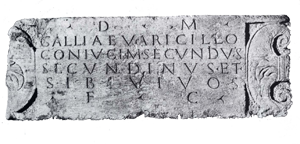The first written document with reference to Niederanven dates at the time of the roman emperor Diocletian from 284 to 305 AD. A Roman card, entitled ” Itinerarium Provinciarum Antonin ” indicates — on the Roman road from Reims to Trier — a stage stopping place situated between Arlon and Trier, namely ” Andethannale vicus Leugas XX “, which means village of Niederanven, 44 kilometres. So due to the handwritten documents, Andethanna is the most ancient name of a village of the Grand duchy of Luxemburg.
 In December, 1919 Gallia Varicillus’s gravestone was found in Hostert. The epitaph translated from Latin says: ” Set up for Gallia Varicillo, (his) wife, by Marcus Secundus Sekundinus. Dedicated to the gods of the shadows. ”
In December, 1919 Gallia Varicillus’s gravestone was found in Hostert. The epitaph translated from Latin says: ” Set up for Gallia Varicillo, (his) wife, by Marcus Secundus Sekundinus. Dedicated to the gods of the shadows. ”
During the years 1661–1677 Alexandre Wiltheim drew up, as a part of his major archaeological work “Luciliburgensia Romana”, a geographic card of Luxemburg at Roman time. “Andethanna” is situated there among Orolaunum ( Arlon) and Augusta Treverorum ( Trier). {Luciliburgensia Romana}
The ancient Roman road, collectively called ” Kiem ” in Luxembourgish, connected Reims with Trier. ” Kiem ” results from the Celtic ” Kehm ” which means road. This road was situated near the current highway — coming from Luxemburg-City through Grünewald up to the neighborhood of the new water tower on Senningerberg. From there it went probably down near the current ” Rue des Romains ” to reach Niederanven. It continued then its road towards Mensdorf. Hostert was connected with this ” main road ” by a secondary Kiem. Nowadays it is presumed that the ancient Andethanna was situated in Hostert.
Only hundred of years later, in 386 AD, the name of “Andethanna” appears again in handwritten documents: in ” Vita St Martin “, Sulpicius SEVERUS describes one of the numerous journeys of the bishop of Tours to Trier. ” The next day, he (for Martinus) quickly raised the camp. On his road of return, he sighed, his soul in pain, for having been, even for so short a period, in such an unhealthy community. All this took place not far from the locality Andethanna, where a road crossed solitary neverending forests. Martinus sat down on the ground “… Suddenly an angel appeared to him and pronounced following words: ” Resume your courage and become strong again “. The locality where, according to the popular tradition, all this would have happened, is called nowadays ” Um Hellegesteen ” what means ” at the stone of the Saint “. That is why the monument of Holy Martin, set up in 1930, is situated next to the “Chaussée St. Martin”.
